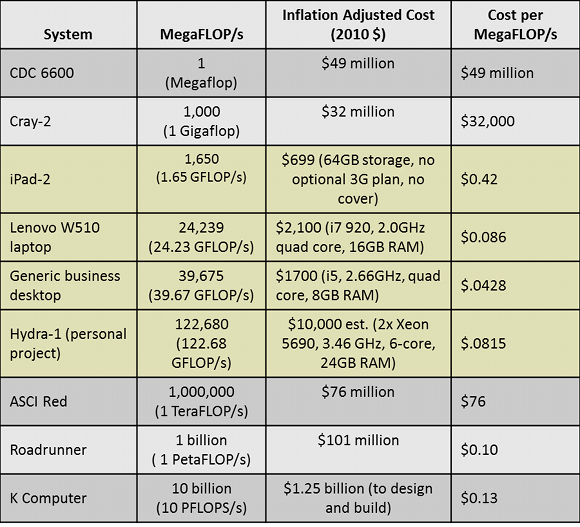This article is more than 1 year old
SUPERCOMPUTER vs your computer in bang-for-buck battle
iPad 2 pwns Cray-2? Wife’s desktop beats all?
A bang-for-buck comparison

The table above is sorted in performance order. The yellowish rows represent the Apple iPad and some systems I have hanging off my office/home network. The astounding part of the table is the final column – the cost per MFLOP/s. What jumps out is that my wife’s generic business desktop computer kicks ass from a price/performance perspective. At less than 5 cents per MFLOP/s, it’s well ahead of everything else on the list.
The Lenovo W510 was billed as a “Mobile Workstation” when I bought it, and it’s the fastest laptop I’ve ever used. It’s also the heaviest and the most power-hungry, but with an Intel Extreme edition i7 mobile processor and a discrete NVIDIA Quadro graphics processor, it can handle the video processing I throw at it when I’m on the road.
A Bugatti of my own
The Hydra-1 system is something I’ve been working on for months, and it’s finally ready to come into service. I’m getting old enough to realize that I’ll never own a Bugatti Veyron ($2.4m) or even the much less expensive Ferrari Enzo ($670,000), but I can have the fastest computer in my state (until someone proves me wrong – plus it’s a small state).
I built Hydra-1 over the past several months, and it’s quite the screamer. A very helpful HPC vendor helped hook me up with two Intel Xeon 5690s which, together with 24GB of RAM, turned in a Linpack of 122.68 GFLOP/s at stock clock frequencies. Hydra-1 has some serious liquid cooling built in, so I have plenty of room for over-clocking, which might take the Linpack to 140 or better. I think I’m way under the Linpack theoretical max for the system, but I’m running the benchmark under Windows 7 without any tuning, so I’ll take what I can get.
The liquid cooling almost drove me out of my mind, but will definitely pay off on performance and comfort fronts. I’ve written some blogs about the whole process that I’ll submit to The Reg soon.
The iPad does okay, but not nearly as well as the typical systems in the chart. And the iPad numbers don’t include a 3G wireless plan or a cover – and the cheapest poly cover at the Apple store costs $39, or about 6 per cent of the total system price. And if you go with leather? At $69, that’ll drive your price per MFLOP up by 10 per cent.
The biggest surprise on our chart above? Look at Roadrunner and the K computer. Their cost per MFLOP/s is a mere 10 cents and 13 cents respectively. I ran the numbers again and again just to make sure I wasn’t dropping a zero (or adding one). But the result remains the same – the fastest and most modern supercomputers are much less per MFLOP than their predecessors.
So what have we learned today? First, even though the cost of computing components has dropped radically over time, the cost of building/buying the biggest landmark computers in the world has increased just as radically.
We’ve also seen that today’s home and business computers stack up very well against supercomputers of the past. The iPad 2 pwns the Cray 2 in Linpack, but costs 99.998 per cent less (leather case not included).
We’ve learned that the current chart-topping supercomputer, the K computer, has a competitive cost per MFLOP/s even though it cost something like $1.25bn to design and build.
But my wife’s desktop is the Linpack price/performance king, and now we know that too. ®
